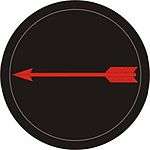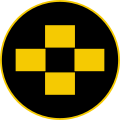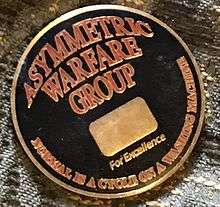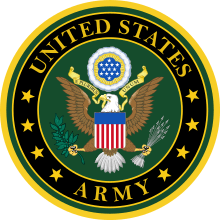Asymmetric Warfare Group
The Asymmetric Warfare Group is a United States Army unit created during the War on Terrorism to mitigate various threats with regard to asymmetric warfare. The unit is headquartered at Fort Meade, Maryland and has a training facility at Fort A.P. Hill, Virginia. The unit provides the linkage between Training and Doctrine Command (TRADOC) and the operational Army, and reports directly to the commanding general of TRADOC.[2] It is composed of senior active duty Soldiers, D.A. civilians, and contractors who are seasoned war fighters and functional area experts that are prepared to deploy globally.[3]
| Asymmetric Warfare Group | |
|---|---|
 Asymmetric Warfare Group shoulder sleeve insignia | |
| Active | 2006 - present |
| Country | |
| Branch | |
| Type | Operational Advisory Support |
| Role | Advisory and solution development |
| Size | ~ 350 |
| Part of | |
| Garrison/HQ | Fort Meade, Maryland |
| Nickname(s) | AWG |
| Motto(s) | "Think. Adapt. Anticipate." |
| Colors | Black & Red |
| Anniversaries | March 8, 2006 |
| Engagements | Iraq War War in Afghanistan |
| Decorations | Army Superior Unit Award |
| Website | www.awg.army.mil |
| Commanders | |
| July 2019 - Current | Colonel Scott Shaw [1] |
| July 2017 - July 2019 | Colonel Timothy O’Brien |
| July 2015 - July 2017 | Colonel Michael Loos |
| August 2013 - July 2015 | Colonel John P. Petkosek |
| July 2011 - August 2013 | Colonel Patrick J. Mahaney Jr. |
| July 2009 - July 2011 | Colonel James M. Mis |
| January 2006 - July 2009 | Colonel Robert Shaw |
| Insignia | |
| Distinctive unit insignia |  |
Organization
The Asymmetric Warfare Group is made up by a headquarters and headquarters detachment and four squadrons, each one led by a lieutenant colonel:
- Able Squadron (Operations)
- Baker Squadron (Operations)
- Charlie Squadron (Operations)
- Dog Squadron (Concepts Integration)
Each squadron is subsequently divided into troops commanded by Lieutenant Colonel (United States).
Mission
.jpg)

The U.S. Army Asymmetric Warfare Group (AWG) provides global operational advisory support to enable U.S. Army forces to win against current and emerging asymmetric threats, and prepare for Large Scale Combat Operations (LSCO).
The key tasks of Asymmetric Warfare Group is: Advise, Scout and to Assist DOTMLPF-P Integration.
History
The U.S. Army Asymmetric Warfare Group (AWG) is charged with identifying Army and joint force capability gaps to doctrine, organization, training, material, leadership and education, personnel, facilities, and policy (DOTMLPF-P), and developing solutions to those gaps. It further seeks to identify enemy threats and develop methods to defeat those threats.
2016 marks the group’s 10th anniversary. In January, 2006, the AWG was established as a Field Operating Agency under the operational control of the Deputy Chief of Staff, G-3/5/7, Headquarters, Department of the Army. The AWG was activated on March 8, 2006, at Fort Meade, MD. The AWG was assigned to the U.S. Army Training and Doctrine Command on November 11, 2011 as a direct reporting unit to the commanding general. The assignment to TRADOC enabled enhanced cooperation with the Army Capabilities Integration Center, Combined Arms Center, and the Centers of Excellence. Since 2011, AWG has experienced a significant growth in Operational Advisory support missions, and activated its third Operational Squadron in 2013. With this enhanced capacity, AWG provides observations, analysis, and solution development into both the operational and institutional forces of the Army. AWG's operational advisors deploy globally to complex operating environments to understand the current and emerging challenges to anticipate the character of future conflict. While their focus is on assisting the operating force, they ensure that any lessons learned are passed to the institutional Army for long-term integration and to enhance the development of our generating force.
AWG conducts vulnerability assessments to identify security risks for the Army, bridge the skill and knowledge gap between Special Operations Forces and the regular Army, and assists the Army in developing and implementing the Army Learning Model through AWG's unique instructing methods, or ASLTE, Adaptive Soldier Leader Training and Education.
Assessing current and emerging threats: AWG determines friendly force vulnerabilities and enemy threat capabilities and then develops programs of instruction to raise situational awareness and understanding of identified problems. AWG then seeks to integrate the programs of instruction into Combat Training Center (e.g., National Training Center) rotations, as well as in-theater JRSOI training. JRSOI is the process that transitions deploying or redeploying forces, consisting of personnel, equipment, and materiel into forces capable of meeting the CCDR’s operational requirements or returns them to their parent organization or Service. In addition, AWG evaluates engagement tactics, techniques, and procedures, and works with the Fires Center of Excellence to institutionalize its findings. AWG has also created a compendium of ISIL techniques and procedures, probable scenarios, and ways to counter them, which are distributed in theater and are available through the Center for Army Lessons Learned (CALL). AWG developed a similar product addressing Russian hybrid warfare based on Ukraine.
Understand the Complex Operating Environment: through AWG’s support to Regionally Aligned Forces and Special Operations Forces, they identified the requirement to bring jungle skills back into the U.S. Army. AWG incorporated lessons learned into the 25th Infantry Division’s Lightning Academy and created handbooks for CALL. In addition, observations and trend analysis from globally-deployed operational advisors identified the requirement to raise awareness of tunneling and subterranean operations. AWG created handbooks and references for distribution by CALL. AWG continuously deploys operational advisors in support of theater security cooperation plans and events to identify how the complex environment is changing around the world. A handbook was developed by AWG after working with Combined Joint Task Force – Horn of Africa to inform future leaders and planners of the operational challenges a CJTF has in an environment where the DoD is not the lead agency.
